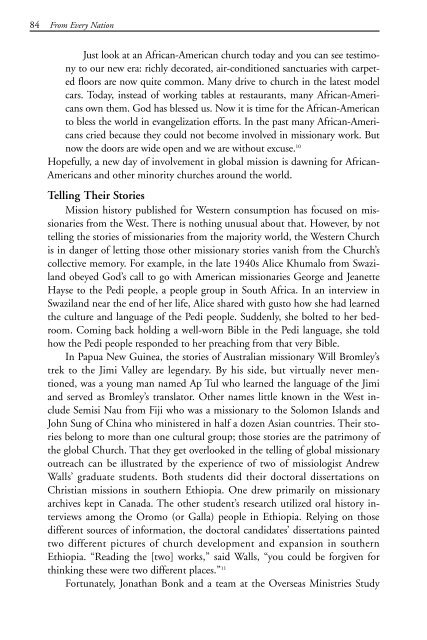discovering missions - Southern Nazarene University
discovering missions - Southern Nazarene University
discovering missions - Southern Nazarene University
You also want an ePaper? Increase the reach of your titles
YUMPU automatically turns print PDFs into web optimized ePapers that Google loves.
245187 Disc Missions ins 9/6/07 1:04 PM Page 84<br />
84 From Every Nation<br />
Just look at an African-American church today and you can see testimony<br />
to our new era: richly decorated, air-conditioned sanctuaries with carpeted<br />
floors are now quite common. Many drive to church in the latest model<br />
cars. Today, instead of working tables at restaurants, many African-Americans<br />
own them. God has blessed us. Now it is time for the African-American<br />
to bless the world in evangelization efforts. In the past many African-Americans<br />
cried because they could not become involved in missionary work. But<br />
now the doors are wide open and we are without excuse. 10<br />
Hopefully, a new day of involvement in global mission is dawning for African-<br />
Americans and other minority churches around the world.<br />
Telling Their Stories<br />
Mission history published for Western consumption has focused on missionaries<br />
from the West. There is nothing unusual about that. However, by not<br />
telling the stories of missionaries from the majority world, the Western Church<br />
is in danger of letting those other missionary stories vanish from the Church’s<br />
collective memory. For example, in the late 1940s Alice Khumalo from Swaziland<br />
obeyed God’s call to go with American missionaries George and Jeanette<br />
Hayse to the Pedi people, a people group in South Africa. In an interview in<br />
Swaziland near the end of her life, Alice shared with gusto how she had learned<br />
the culture and language of the Pedi people. Suddenly, she bolted to her bedroom.<br />
Coming back holding a well-worn Bible in the Pedi language, she told<br />
how the Pedi people responded to her preaching from that very Bible.<br />
In Papua New Guinea, the stories of Australian missionary Will Bromley’s<br />
trek to the Jimi Valley are legendary. By his side, but virtually never mentioned,<br />
was a young man named Ap Tul who learned the language of the Jimi<br />
and served as Bromley’s translator. Other names little known in the West include<br />
Semisi Nau from Fiji who was a missionary to the Solomon Islands and<br />
John Sung of China who ministered in half a dozen Asian countries. Their stories<br />
belong to more than one cultural group; those stories are the patrimony of<br />
the global Church. That they get overlooked in the telling of global missionary<br />
outreach can be illustrated by the experience of two of missiologist Andrew<br />
Walls’ graduate students. Both students did their doctoral dissertations on<br />
Christian <strong>missions</strong> in southern Ethiopia. One drew primarily on missionary<br />
archives kept in Canada. The other student’s research utilized oral history interviews<br />
among the Oromo (or Galla) people in Ethiopia. Relying on those<br />
different sources of information, the doctoral candidates’ dissertations painted<br />
two different pictures of church development and expansion in southern<br />
Ethiopia. “Reading the [two] works,” said Walls, “you could be forgiven for<br />
thinking these were two different places.” 11<br />
Fortunately, Jonathan Bonk and a team at the Overseas Ministries Study

















